Dr. Spaceman
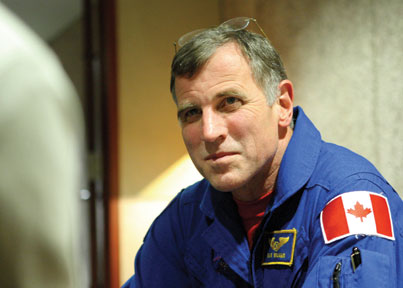
Owen Egan
Astronaut Dave Williams has hung up his flight suit, but he's not done with space just yet.
BY JAMES MARTIN, MLIS'05
Dave Williams's new house in Oakville, Ontario, reminds him of the space shuttle cargo hold. There are boxes everywhere ("total chaos") but instead of freeze-dried food and hi-tech electronics destined for the International Space Station, these boxes contain the usual trappings of family life. And, thanks to an annoyance called gravity, these boxes don't float. "It makes me wish I was back in space," he quips, "where I could just push them around."
Williams had been living near Houston, home to NASA's Johnson Space Center, since 1995; the return home to Canada follows his February 2008 retirement from active astronaut status. After two missions and three space walks (with 17 hours and 47 minutes under his belt, he holds the Canadian record for extravehicular activity), he now wants to spend more time with his wife, Cathy, and their children, Evan, 13, and Olivia, 10. "The hardest part of being an astronaut is the time being away from your family," he says. "You can be training for up to five years for a mission, in multiple countries, for two or three months at a time. Then there is the time actually away in space."
This spring, Williams joins McMaster University as a professor of surgery and director of the Centre for Medical Robotics at St. Joseph's Healthcare Hamilton, where he'll explore how to adapt space robotics, such as the Canadarm, for earthly use. He's also a member of the newly struck Advisory Committee on the Canadian Space Agency, which will audit the CSA's strengths and challenges. Space will still be very much on his mind. Then again, it always has been.
BEACONSFIELD AND BEYOND
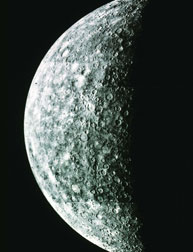
Summer 1961: Seven-year-old Dafydd "Dave" Williams was obsessed with Project Mercury. He watched TV broadcasts of the first Americans to make suborbital flights into space. He made regular bicycle pilgrimages from his Beaconsfield, Quebec, home to Roy's Drugstore in nearby Beaurepaire, spending his Montreal Star paper route money on astronaut bubblegum cards. He absorbed photos and statistics about the Mercury Seven, but they were Americans, and Canada didn't have a human space program. So he dreamt a new dream: to live, not in space, but under water.
Inspired by Dr. Joe MacInnis, the pioneering Canadian aquanaut, 13-year-old Williams began studying how the body adapts to extreme environments. Medical school was an obvious choice. After finishing his studies at McGill—BSc'76, MSc'83, MDCM'83—Williams completed residencies in family practice and emergency medicine. Then, in 1992, Williams's astronaut dreams were revived: While director of the emergency room at Toronto's Sunnybrook Health Sciences Centre, he was plucked by the Canadian Space Agency from a field of 5,330 applicants. Six years later, he blasted off on space shuttle Columbia as an international mission specialist for STS-90. The 16-day mission, dubbed Neurolab, was dedicated to researching how microgravity affects the brain and nervous system.
(Williams did finally become an aquanaut, too. In 2001, he made history as Canada's first astronaut-aquanaut, spending seven days working in Aquarius, a research laboratory located 60 feet beneath the Florida Keys.)
In August 2007, he flew again, this time on the Endeavour, to deliver supplies—and a 2,200 kilogram truss—to the International Space Station. This mission, however, was particularly special for Williams: He was going outside.
Families of astronauts cannot relax until the crew step back onto terra firma; history has proven take-off and re-entry to be perilous propositions, and what happens in between isn't without danger, either. Williams's family knew what he was getting into. They knew he would be going on his first spacewalk to install the S5 truss on the ISS. He didn't keep this a secret. In fact, he brought it home. Williams is a big believer in what he calls "mental imagery" so, in the weeks leading up to STS-118, he would lie on the living room sofa in suburban Texas, eyes closed, and visualize his every movement along the ISS handrail. He'd heard the stories of astronauts freezing during spacewalks, paralyzed by fear, unable to move forward or back. They get disoriented when the Earth appears above them instead of below, forgetting that, in space, "up" is simply where your head is. Williams wasn't going to freeze. "If there's something I want to do," he says, "I can't do it successfully if I can't do it in my head." So, night after night, he spacewalked. (Olivia insisted dad was just napping.)
But there was one little detail that Williams kept from his family until shortly before Endeavour launched.
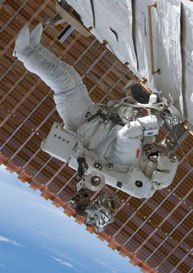
Williams’s first spacewalk, to install a truss on the International Space Station, lasted six hours, 17 minutes.
NASA
Flight Day Four: Dave Williams and Rick Mastracchio have successfully used Canadarm2 to install the S5 truss. Now, in order to allow S5 to function, all Williams needs to do is move the Canadarm grapple fixture. But moving the grapple means also moving his foot restraints… far away from the handrails. Feet anchored, body floating perpendicular to the starboard side of the ISS, Williams now kicks. He trained for this in a pool, but water offers much more resistance than space; the trick here will be to kick with enough force to free himself from his foot restraints, without shooting backwards into the endless blackness. Feet freed, he hangs in space by his thin waist tether. Hand over hand, just like he practised in his mind, he pulls himself through the cold vacuum of space.
Back in the airlock, six hours and 17 minutes after they left, the astronauts exchange silent looks. Then:
"Man," says Mastracchio, "it's crazy out there."
SUCCESS, FAILURE AND INSPIRATION
For connoisseurs of space collectibles, "flown" is unbeatable. A strip of wire, a coin, the flight patch from a uniform: If some scrap of human civilization has left the planet, however briefly, people want it. Williams isn't interested in peddling used toothbrushes on eBay (NASA frowns on such entrepreneurship anyway), yet he deeply understands this allure of holding something which has transcended the terrestrial.
Astronauts fly under tight luggage restrictions, but they're allowed to pack a few special things in their personal preferences kit (PPK). When Williams flew on STS-90, so too did Cathy's pilot wings (she flies Airbus A320s for a living, "the real pilot in the family") and his Wood gold medal, received for outstanding clinical performance during med school. He also took a little piece of McGill's Osler medical library in his STS-118 PPK: A framed flown postcard of the Osler Niche, which holds Sir William Osler's writings and favourite books, will soon be displayed in the library.
The Osler library was a special place for Williams during his time at McGill. "Sitting there with the light difusing through the stained glass windows, surrounded by books," he recalls, "I really got a sense of the history of medicine. And if I got bored with whatever I was studying, I could literally grab a book off any shelf and get immersed in something really, really exciting. In the future, some undergraduate student sitting in the Osler library, dreaming of becoming a practitioner or a scientific researcher, will look at that postcard and hopefully get stimulated."
NASA has declared its intention to return to the moon by 2020 and, eventually, send manned flights to Mars. Never say never—as director of life sciences at NASA, he gave the go-ahead for John Glenn to return to space at age 77—but Williams probably won't be setting foot on either world. "My biggest dream is now not to fly another space flight, but to enable the next generation to become part of the program," he says. "Will someone out there in Canada right now participate in the next international missions to the moon? It's exciting to think that person is in university right now. And the person who will represent Canada when we go to Mars is probably seven or eight years of age right now."
It's not exactly a golden period for the Canadian Space Agency. Retirement has dramatically shrunk its astronaut corps, and leadership has been shaky (the agency has had three leaders in as many years)—as well as weathering general criticisms that Earth's myriad problems should take precedence over costly space explorations. But, with the CSA's announcement that it will hire two new astronauts by May 2009, the time is particularly ripe for Williams's vocal optimism.

During a visit to his alma mater, Beaconsfield High School, Dave Williams signs an autograph for student Caitlin Griffin.
Owen Egan
"If you look back over the last 40 years," he argues, "space exploration has been the driver of so many technological innovations that are now part of everyday life." Hubble telescope technology has been repurposed as a non-surgical breast biopsy technique. Underprivileged communities in Afghanistan, Iraq and other nations use an affordable, non-chlorine water purification system spun off from space shuttle technology. Neurosurgeons are exploring how a miniaturized version of Dextre, Canadarm2's robotic "hand," will radically improve surgical precision and safety. NASA aerodynamics even made a better golf ball. (It's all in the dimples.)
"If you were to look at everything that was derivative of the space program, there'd be a little logo on everything. Now, in order to get further into space, and to stay there longer, we'll need different technologies that are smaller, that have different power supplies, that last longer, that don't generate large amounts of trash. If we're going to live on the surface of the moon, for example, trash management will be a huge issue; if we drive the technologies to manage trash on the moon, we can take those technologies and spin them off for use on Earth."
Williams believes in the boundless potential for human achievement, whether on a personal or grand scale. "Dave works very hard," says astronaut Steven MacLean, who became close friends with Williams when the two trained together. "There are more switch positions in the space shuttle cockpit than there are parts in an American car—you can't learn that in just a couple of days, you need a methodical approach to learning so you're able to keep that data for a long period of time. You can't just be talented, you also need that good work ethic." Williams himself likes to joke that he's been doggedly trying to learn how to play Mason Williams's tricky "Classical Gas" since he was 13 years old. (The song, incidentally, was the theme music for NASA's official Apollo 4 mission film.) Recently, while reading a book entitled How to Play Rock Guitar, he stumbled on a maxim: "Successful people are willing to do things that others won't." It could be Dave Williams's mantra.
When Williams talks to students, as he did on a recent return to his alma mater, Beaconsfield High School, he stresses that "if you fail, not to conclude that you are a failure." His career path may appear smooth to the outside eye, but he insists otherwise. (Yes, even astronauts fail algebra exams. Williams did.)
"Whether you're memorizing all the carbon elements and amino acids in the Krebs cycle, or memorizing every note on the fret board of a guitar," he says, "it's easy to give up. But the most rewarding thing is to keep going, to experience the frustrations and the challenges. The bolder you dream, the harder it is to achieve. I've experienced many challenges in my career. It's not been a straightforward slam-dunk—I think about all the Saturday nights spent studying until the Osler library closed at midnight, when I could've been out playing hockey or going to a party or going to a movie. Sometimes things don't work out as you'd planned, so you have to figure out a different way to attack it from a different angle—and that's what's really important. Through that adversity comes the greatest reward."
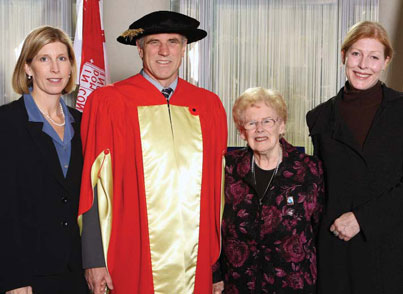
In October 2007, Williams received an honorary Doctor of Science degree from McGill. He was joined at convocation by (from left) his wife, Cathy Fraser, his mother, Isobel Williams, and sister-in-law, Joan Fraser.
Owen Egan
THE SOUNDS OF SPACE
Over the years, Williams has had the good fortune to meet several of his guitar heroes. He once gave B.B. King a commemorative medallion stamped from melted bits of a decommissioned space laboratory. King, it turns out, is a space enthusiast; he peppered the astronaut with questions for 40 minutes. When Williams met Eric Clapton after a Houston concert, he boldly suggested that "music can do something the space program can't."
Slowhand was stumped: "What's that?"
"Transport you through time."
For Williams, there's an inextricable, and profound, connection between memory and music. Some 400 kilometres above, or below, the Earth, he liked to gaze homeward while listening to Clapton and King, Lennon and Vivaldi on his iPod. "I can't overstate the influence music has while experiencing all these amazing things," he says. "When I'm in space, I take away a totally different perspective when I'm listening to music compared to when I'm not."
So even if Dave Williams never returns to the space station, or sets foot on the moon, all it takes is a few bars of Armstrong (Louis, not Neil) and suddenly he's back in space, watching jet contrails dissipate across Earth's lower atmosphere, bilge dumps creep across oceans, storms swirling Saharan sands. When these memories come flooding back, they bring with them a renewed sense of pride, purpose and hope.
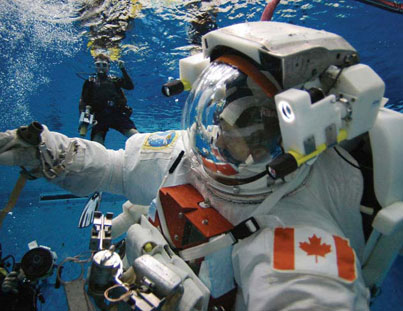
Dave Williams trains for his spacewalk in the Neutral Buoyancy Laboratory near Johnson Space Center.
NASA
"When I tour around and talk to people, pretty much everyone has the same goals," he says. "They want a nice, safe place where they can grow up, and watch their kids grow up, have educational opportunities, and simply enjoy being here on Earth. Being in space, and looking at the planet from a distance—at this amazingly beautiful place in the cold, dark infinite void of space—you certainly get the sense of 'Why can't we do that together?'"
James Martin is the editor of Headway, McGill University's research magazine. He profiled astrophysicist Vicky Kaspi in the Summer 2007 News, and has written for Saturday Night, enRoute and Sassy.
Search
Search (skip):
MORE SPACE ACES
NASA will retire its space shuttle fleet in 2010, but not before flying another McGill alum—and a member of the extended family—into the stars. In April 2009, Julie Payette, BEng’86, will serve as a mission specialist aboard the space shuttle Endeavour, which will deliver the final pieces of Japan’s Kibo laboratory to the International Space Station; it will be her second space mission, having previously flown on the Discovery in 1999. This August, astronaut Andrew Feustel, the husband of Indira Feustel, BSc’88, is scheduled to fly aboard the Atlantis on a mission to repair the Hubble Space Telescope.
Julie Payette is not the only McGill grad returning to space next year, either. In May 2009, Robert Thirsk, MDCM’82, will begin a several month stay aboard the ISS—a Canadian first. He will travel to the station on a Soviet Soyuz craft launching from Kazahkstan. Dr. Thirsk last went into space in 1996, serving as payload specialist on the Columbia.


